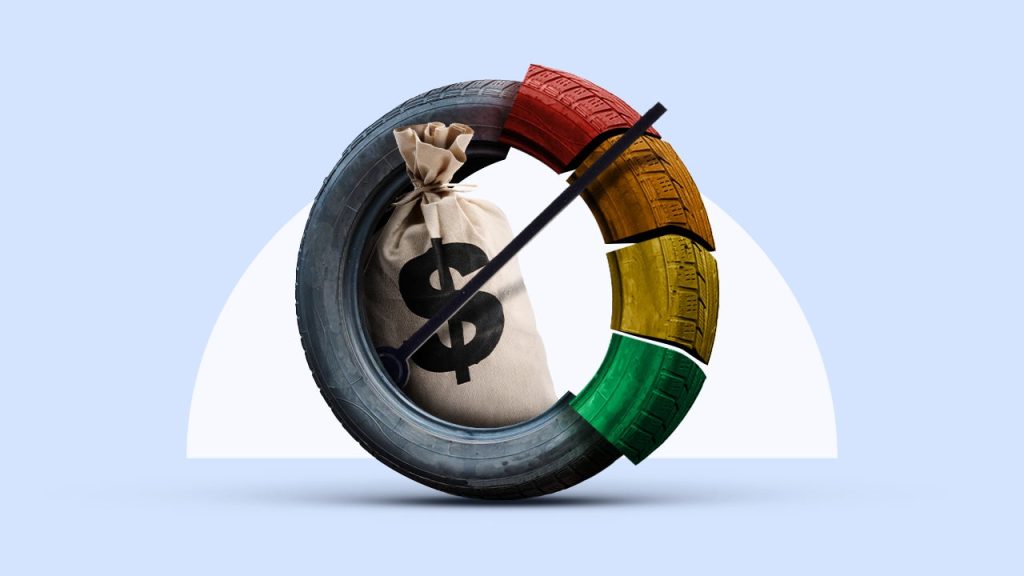Key takeaways
- You should still shop for the best auto refinance rates and terms even if you have bad credit — there is still a chance to find a competitive option for your budget.
- Refinancing your car loan with bad credit may make sense if you can lower your monthly payment by spreading your loan out over a longer term.
- If refinancing your car loan isn’t an immediate need, take steps to improve your credit score to qualify for better rates and more flexible terms.
If you’re finding it hard to make your car payment every month due to rising costs, increasing car insurance premiums or unexpected expenses, auto loan refinancing may provide some relief. With bad credit, the cost of refinancing may outweigh the benefits, especially if your loan is almost paid off. In that case, you may want to explore some alternatives.
This means that it may be more challenging to get approved for a car refinance with bad credit, and you are unlikely to qualify for a lower average annual percentage rate (APR). Refinancing usually saves you the most if you can get the best auto loan rate, but extending the term on your remaining loan balance could significantly reduce your monthly payment even if don’t qualify for a low APR.
Is it possible to refinance a car loan with bad credit?
You are able to refinance a car loan when you have bad credit, but it may be more difficult and substantially more expensive. Lenders may require that the vehicle have significant equity, be a newer model year or have low mileage. You may also need to meet more stringent debt-to-income (DTI) ratio requirements than a borrower with excellent credit.
You will also need to meet standard title requirements, which means you may have a tough time refinancing a salvage title vehicle. You may also need a lower loan-to-value ratio (LTV) to give the lender more equity if it has to repossess and resell your vehicle due to default.
How to refinance a car loan with bad credit
Just like shopping for a new or used car, the process of refinancing a car loan with bad credit requires more upfront research. You don’t want to waste time shopping at a lender if your vehicle doesn’t meet its bad credit lending requirements.
If you decide to move forward, the steps to refinancing your auto loan are fairly similar, regardless of whether you have good or bad credit. Start by considering the pros and cons of refinancing and reviewing your financial situation before you decide on a lender.
1. Research each lender’s vehicle requirements
Standard LTV, mileage and vehicle refinance requirements may not apply if you have bad credit — but lenders may not be upfront about strict requirements online. You may need to call the customer service line and connect with a representative to ask questions.
Here’s what you should find out before taking any steps:
- What is the minimum and maximum I can borrow with bad credit?
- What is the maximum LTV ratio?
- How much equity do I need to have in my car?
- Are there any restrictions on the make, model, age or mileage requirements?
Even for borrowers with good credit, lenders typically restrict refinancing to vehicles that are under 10 years old or have less than 100,000 miles. You may need a lien-free title, a strong income or minimal debts in addition when you apply to refinance with bad credit.
2. Check your credit score
Your credit score will determine your interest rate, loan amount, loan terms and, in some cases, the vehicle requirements for approval. Bad credit lenders set different standards and rates to offset the perceived risk you might not be able to repay the loan.
Review your credit score and credit report to avoid any surprises before you start shopping to refinance your auto loan. If you notice any inaccurate or outdated information, file disputes promptly with the credit bureaus — Experian, TransUnion or Equifax. And if possible, wait to refinance until you have improved your credit score — this can help get you lower interest rates and a better overall deal.
3. Explore your options
You can check if your existing lender offers refinancing options for current borrowers, but it is more likely that you could request car loan modification rather than refinancing. If that option doesn’t save you money, you may want to consider some of the bad credit marketplace and auto lenders featured on Bankrate.
You may also want to consider any banks or credit unions you currently do business with. Try to choose lenders that offer prequalification to avoid unnecessary damage to your credit score while you’re comparing refinancing options.
Once you have a few quotes, compare your monthly payment and lifetime interest with prequalified offers to determine if refinancing makes sense. Use Bankrate’s auto loan refinance calculator to calculate potential cost savings. To be sure refinancing is the right option, you will either want the monthly payment or total interest paid to be lower. If neither is the case, refinancing may not be the right move.
4. Apply for a new loan
Before submitting a loan application, gather any documents the lender will need to expedite the review process. You will typically need the following items:
- Your car’s mileage, make, model and VIN.
- Proof of income and residency.
- Information about your current auto loan.
- Your auto loan’s payoff quote.
- Your existing auto insurance policy.
When you apply, be as accurate as you can about your income to avoid a denial later. The lender will vet the information you provide and may require more to approve your loan with bad credit. You may need to provide additional documents if you’re self-employed or have a variable income.
5. Finalize the loan
Review the loan documents to ensure the terms and conditions match up to what you reviewed when you prequalified. If everything is correct, most lenders will allow you to electronically sign paperwork to finalize the transaction. Your new lender will send the loan amount directly to your current lender to pay the original loan off.
Check with your lender to see when you begin making payments. From here, you will follow the new monthly payment schedule until you pay off your refinanced loan.
Bankrate tip
You’re responsible for payments to your current lender until the refinancing process is complete. Confirm when the old loan will be paid off, and double-check your old loan balance to make sure it is complete.
Banks that will refinance your car with bad credit
Most major banks and credit unions only offer auto loan refinancing to borrowers with at least fair credit. Some may make exceptions if you have a long-standing relationship, but more than likely, they will pass on a bad credit auto refinance request.
Marketplace lenders — services that aggregate online lenders — have grown in popularity over the past several years. They partner with several financial institutions to meet the needs of borrowers who want or need to refinance with bad credit.
These marketplace sites currently featured on Bankrate offer bad credit auto refinance options. Many will accept scores under 620, though you should expect higher interest rates and less favorable terms.
| Lender | APR | Best for | Minimum credit score |
|---|---|---|---|
| RefiJet | 5.29%-21.99% | Drivers with very low credit scores who can take advantage of the lenders two-month payment hiatus option. | 500 |
| Autopay | Starting at 4.85% | Comparing loan options side-by-side without a hard credit pull. | 580 |
| Caribou | 5.48%-28.55% | Those who are looking for extra online support during the refi process. | 600 |
| Upstart | 5.41%-29.99% | Drivers who have poor credit and require flexible acceptance criteria. | 510 |
When to consider refinancing with bad credit
While it’s always better to refinance when your credit score is higher, there are some situations when a bad credit car refinance makes sense.
- You can’t afford your current loan payment. If you’ve suddenly experienced a drop in your household income or an increase in your ongoing expenses, a three-year or less auto loan payment can stress your finances. Refinancing can extend the term and give you room in your budget.
- You’ve got plenty of equity. If you have already paid down a good chunk of your loan, you can refinance less. That can lead to a much lower payment on the new refinanced balance, especially if you extend your loan term.
- Your car is relatively new. Lenders may scrutinize your car more if you have bad credit. A newer, well-maintained vehicle with low mileage car will be a better risk for a lender — and may increase your chances of approval if you have bad credit.
- Auto loan rates have dropped. Economic factors can sometimes cause the Fed to lower auto loan rates quickly, which could put you in a position to refinance to a lower bad credit rate. If you start getting a lot of notices about car refinance rates falling, check them out to see if refinancing makes sense.
Risks of refinancing with bad credit
There are some significant risks of refinancing a car with bad credit. Knowing them can help you avoid putting you into a worse financial situation.
- You could end up paying more total interest. Lenders start a new loan term when you refinance your auto loan. If you choose a longer repayment term than you currently have for your refinance, you’ll pay more total interest.
- You’ll make less if you have to sell your car. Cars lose value relatively quickly as they get older. If you refinance to a longer term and are still carrying a loan balance later in the car’s life, you could significantly reduce the amount you net when the car is sold.
- You might pay prepayment penalties. Although they’re rare, if you owe the lender a fee for paying your current loan off early, refinancing may not be worth it.
- You could lose your car in a repossession. Car refinance lenders have the same recourse to repossess your car if you can’t pay your loan back. The faster you pay the balance off, the sooner you remove that risk.
Bankrate tip
To get a lower auto loan refinance rate, consider boosting your credit score. With auto loan rates ranging from 5 to 21 percent, the extra effort could add up to solid savings.
Alternatives to car loan refinancing
Other options are available if you decide that refinancing your car loan isn’t a smart financial move until you’ve improved your credit score.
- Trade it in. Depending on your car’s value and how much is owed on the current loan, you could trade it in for a more affordable option and possibly roll the outstanding balance into a new, longer-term loan. Just be aware that rolling your balance over could put you upside-down on your next loan.
- Request modification. If your current lender won’t refinance your loan or doesn’t offer it as an option, you could request loan modification. This allows you to adjust payment terms — and sometimes interest rates — without going through a new application process. However, you may have to be delinquent on payments to qualify for this option, which could further damage your credit.
- Defer payments. This is only available if you’re facing short-term financial hardship, but it is an option. You may be able to skip up to three months of payments, but they will be tacked on to the end of your loan and still be accruing interest.
- Adjust your budget. Rework your spending plan to make the payments more affordable until you qualify for refinancing. You should also improve your credit score in the meantime to get a better interest rate when you apply for a new loan.
- Use a cosigner. Do you have a trusted friend or family member with strong credit? Adding them as a cosigner can help your approval odds and potential interest rates. Make sure to explain the risks and seek their permission first.
Bottom line
Unless you are experiencing financial hardship, refinancing your auto loan with bad credit is typically a risky option. If you decide to refinance with a longer term to lower your payment, remember: you can always make extra payments to reduce your term if your financial situation improves. If you bought too much vehicle for your income and budget, it may make more sense to trade the vehicle in and downsize to something that’s more affordable.
Read the full article here












